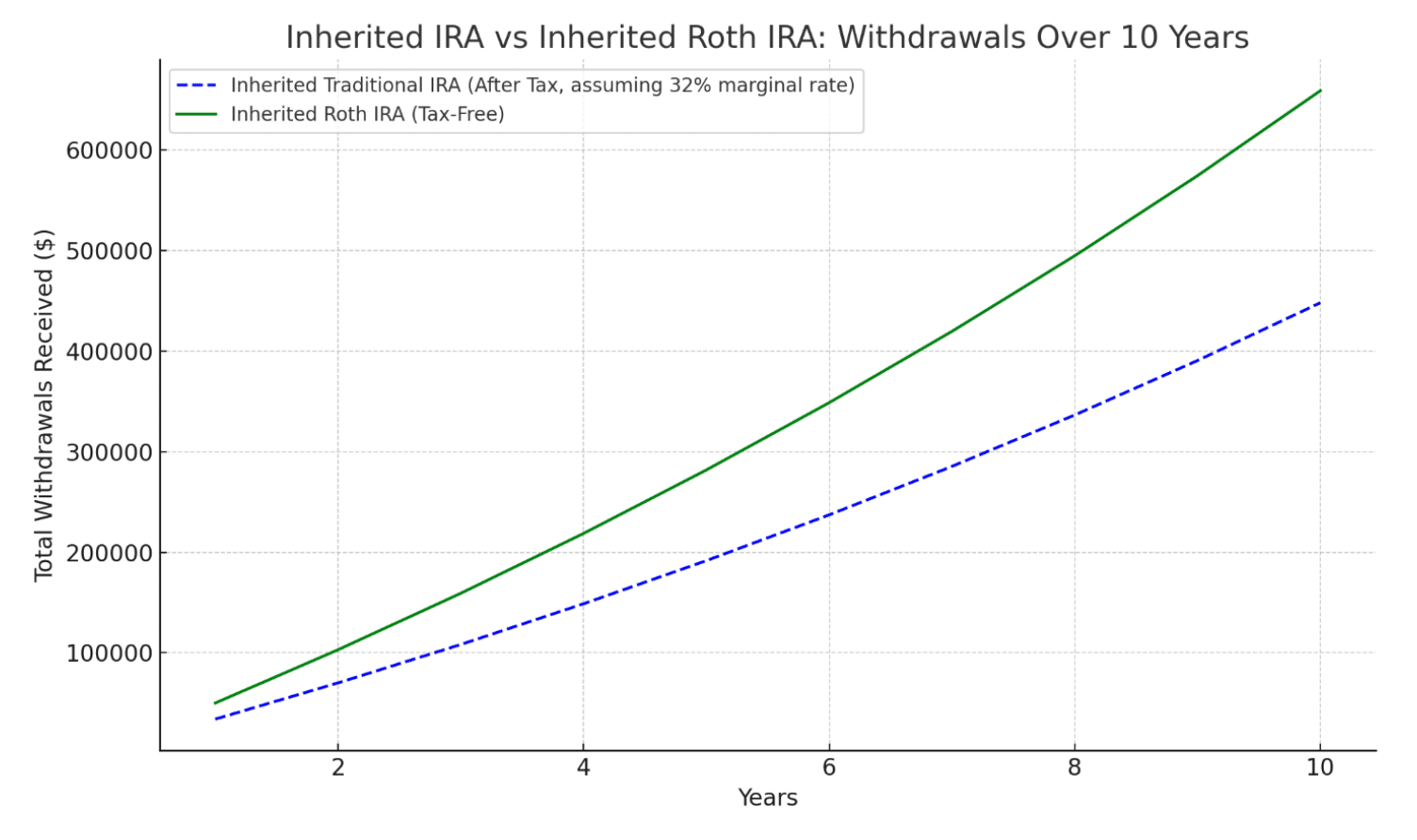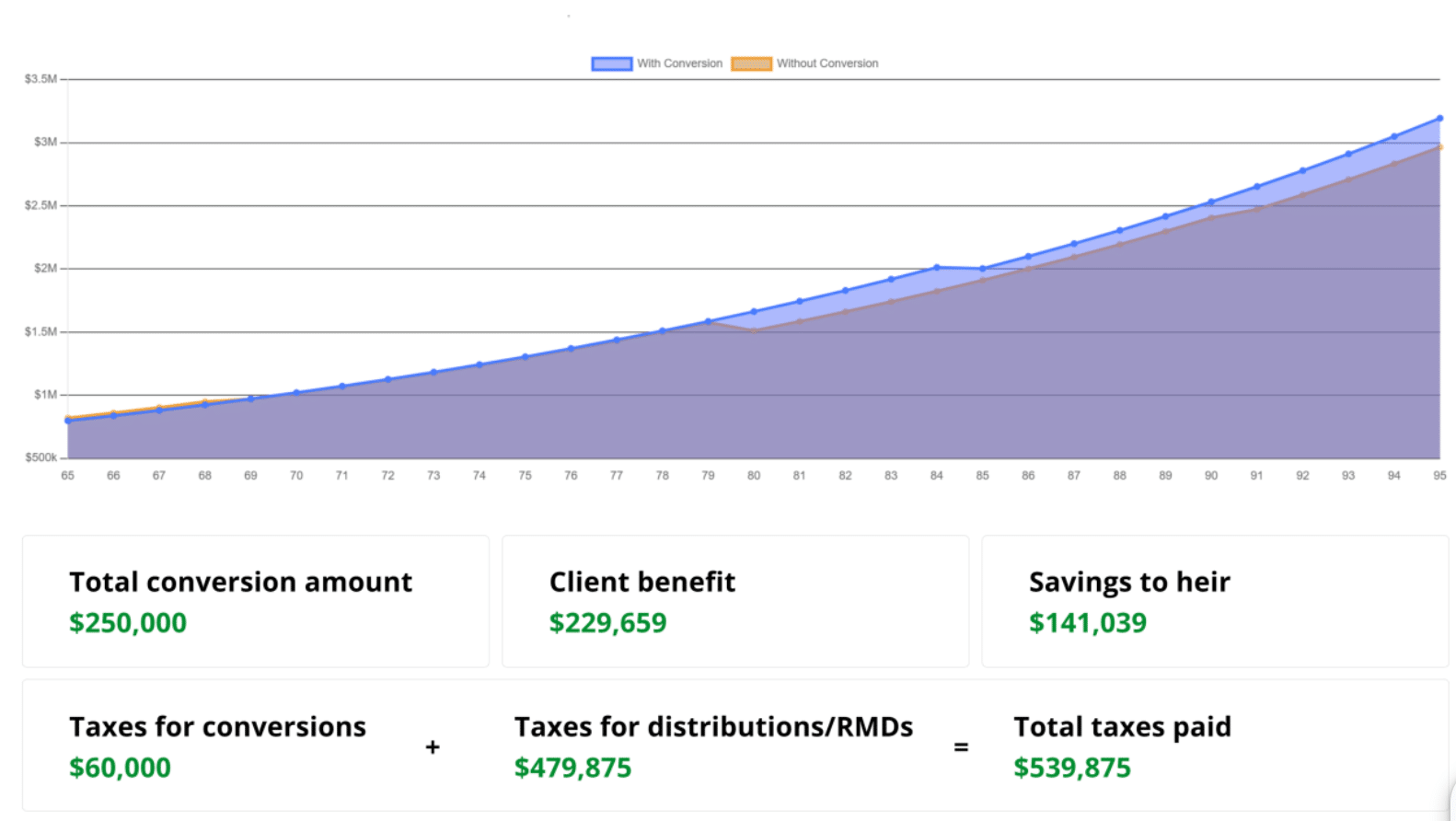A Roth IRA is a retirement savings account that allows individuals to contribute after-tax dollars, with the significant advantage that qualified withdrawals*—including both contributions and earnings—are completely tax-free in retirement. This contrasts with traditional IRAs, which are funded with pre-tax dollars and taxed upon withdrawal.
Table of Contents
- 1 Why Roth IRAs Matter More Now: The SECURE Act and Legacy Planning
- 2 Why Consider Roth Now?
- 3 How to Get Money into a Roth Account
- 4 Roth Options for High Earners
- 5 Give Kids a Head Start: Custodial Roth IRAs for Young Earners
- 6 Who Should Consider Roth Strategies?
- 7 Final Thoughts
Why Roth IRAs Matter More Now: The SECURE Act and Legacy Planning
The SECURE Act, which took effect in 2020, brought major changes to Inherited IRAs. Non-spouse beneficiaries must now withdraw the entire account by the end of the 10th year following the original owner’s death. For heirs, this oftentimes means inheriting their parents’ IRAs in their peak earning years. Now, with 10 years to empty the account under a high tax bracket, this can significantly reduce the inheritance’s value.
While the 10-year rule still applies to Inherited Roth IRAs for non-spouse beneficiaries, there’s no tax on the distributions, making them an excellent tool for intergenerational wealth transfer.

This graph compares total cumulative withdrawals over 10 years from an Inherited Roth IRA vs. an Inherited Traditional IRA. Both accounts start with an estimated $500k and experience investment growth over time. The Roth IRA allows for tax-free growth and withdrawals, resulting in over $650,000 being received after 10 years. In contrast, the Traditional IRA, taxed at a 32% marginal rate, yields significantly lower cumulative withdrawals.
Why Consider Roth Now?
- Tax Rates Are Historically Low: Locking in today’s lower rates could benefit those expecting to be in higher brackets later.
- Roth Contributions = Tax Insurance: Traditional IRA funds grow with a tax liability attached. Converting to Roth is a way to settle your “debt” to the IRS now and allow your money to grow tax-free.
- More Flexibility in Retirement: Roth IRAs have no Required Minimum Distributions (RMDs) during your lifetime.
How to Get Money into a Roth Account
1. Roth IRA Contributions
If you earn under certain income limits, you can contribute directly:
- 2025 limit: $7,000 ($8,000 if age 50+)
- Retirees with part-time income are eligible to contribute. Note: pensions, Social Security, Non-taxable Alimony, Rental Income, and investment income do not count as earned income.
Pro tip: If one spouse is still working, the non-working spouse can make a Roth IRA contribution based on the working spouse’s income.

2. Roth IRA Conversions
You can convert assets from Traditional IRAs, SEP IRAs, SIMPLE IRAs, or 401(k)s into a Roth IRA, regardless of your income. You’ll pay taxes on the converted amount now, but future growth and withdrawals can be tax-free.
This can be a great strategy for:
- New retirees who have large IRAs and would like to build their Roth bucket.
- Young professionals who are in lower tax brackets and have IRAs or 401ks from past employers
- Dual income families who have recently transitioned to a one-income household and are now in a lower tax bracket
It is important to be strategic with the timing of the conversions to minimize taxes paid. Look for years when you will have lower income – e.g., the years between retirement but before you claim Social Security or take RMDs. Additionally, down markets are great opportunities to convert depreciated assets and let them grow tax-free.
Waiting to convert towards the end of the year allows you to have a better understanding of your income and in what tax bracket your conversion would fall. Your tax accountant can help you calculate the amount to convert to stay within your tax bracket and anticipate any impacts to your Medicare premiums (IRMAA).
Pro Tip: Withdrawals after the age of 59.5 and the earnings after 5 years are also tax-free. The 5-year duration is calculated from the 1st day of the year you contribute/convert to your Roth IRA. Doing a conversion in December takes almost a year off the 5-year requirement.
Case Study: Maria, Age 65, Retired
Maria is in a moderate tax bracket and converts $50,000/year over five years, paying 24% in taxes. Had she delayed these withdrawals until required minimum distribution (RMD) age, her growing IRA balance – combined with Social Security – would likely push her into a higher 32% tax bracket. By converting now, Maria secures a lower tax rate and reduces her future RMD obligations (approx. lifetime client benefit of $229,659). Her children/beneficiaries will inherit her Roth giving flexibility of distributions during the 10-year period and avoid taxes—preserving more of her legacy (approx. savings to heirs $141,039, assumed 32% heir tax bracket).

This graph compares the impacts of converting $50k/yr for 5 years from a $1mil IRA into a Roth IRA vs. not converting.
Roth Options for High Earners
1. Roth 401(k)s
Another great option to get money into a Roth account is through your employer retirement plan. Check your 401k, TSP, 403b, or 457b to see if you have this option. The best parts, there are no income limits, and you can contribute much more!
- 2025 limit: $23,500 ($31,000 catch up for age 50+, $34,750 super catch up (new starting this year!) for ages 60-63).
- Can be rolled into Roth IRAs at retirement (with no tax consequences)
- For some, the choice between a Roth 401(k) and a Traditional 401(k) comes down to determining whether the upfront tax break on the Traditional 401(k) is likely to outweigh the back-end benefit of tax-free withdrawals from Roth 401(k). Often, this isn’t an “all-or-nothing” decision. Many employers allow contributions to be divided between traditional and Roth accounts. Consult a financial advisor for advice on the contribution method that would be most beneficial to you.
Case Study: Quinn, Age 51, Business Owner
Quinn maxes out her Roth 401(k) at $31,000/year. She plans to retire in 10 years. Her current tax bracket is 24%, and she expects to be in the same or higher bracket in retirement. Choosing Roth now locks in today’s tax rate and ensures future withdrawals are tax-free.
2. Backdoor Roth Conversion
For those who are earning too much for direct Roth IRA contributions and are already maximizing their retirement plan, a backdoor Roth IRA is a great option. It’s a legal, IRS-sanctioned strategy often used by high-income earners to access Roth accounts.
Contribute to a Traditional IRA
-
-
- For 2025: Up to $7,000 ($8,000 if age 50+).
- This contribution is made with after-tax dollars (you get no tax deduction).
-
Convert to a Roth IRA
-
- Immediately after funding the Traditional IRA, convert it to a Roth IRA.
- Since the contribution was made with after-tax dollars, the conversion is generally tax-free—if you have no other pre-tax IRA balances across all IRAs.
Pro tip: The IRS looks at all your traditional IRAs together when calculating taxes on your conversion. This “pro rata rule” means that having existing traditional, SEP-IRAs, or SIMPLE IRAs could affect your tax bill. We highly recommend consulting with your tax accountant and financial advisor when considering this strategy.
Case Study: Ahmed & Priya, Ages 38 & 41, Professionals
With a $350,000 income, Ahmed & Priya each contribute $7,000 annually to their traditional IRAs, then convert immediately. Over 10 years, they will have moved $140,000 (plus growth) into Roth IRAs, creating a growing pool of tax-free retirement assets.
3. Mega Backdoor Roth Conversion
If you’re a high-income earner and already maxing out your 401(k), the Mega Backdoor Roth strategy may allow you to save even more in tax-advantaged accounts.
Here’s how it works: Some employer-sponsored retirement plans (like 401(k)s) allow after-tax contributions beyond the standard $23,500 employee deferral limit (or $31,000 for those 50+, $34,750 ages 60-63 in 2025). In total, the IRS allows up to $70,000 in 2025 ($77,500 for those 50+, $81,250 ages 60-63) to be contributed to a 401(k) plan—including employee deferrals, employer matches, and after-tax contributions.
If your plan permits it, you can:
- Contribute after-tax dollars to your 401(k), beyond your regular deferral up to the limit.
- Convert those after-tax contributions to a Roth 401(k) or roll them out to a Roth IRA—often immediately (known as an in-plan Roth conversion or rollover).
This strategy allows for potentially tens of thousands of dollars to enter Roth accounts each year, far beyond the regular Roth IRA contribution limits.
Case Study: Jordan, Age 44, Professional
Jordan’s employer allows after-tax 401(k) contributions. After maxing out his regular 401(k) deferral with a $23,500 pre-tax contribution, he contributes an additional $20,000 in after-tax dollars from his bonus. His plan allows him to immediately convert this to a Roth 401(k). By doing this each year, Jordan could accumulate a substantial Roth balance over time.
Pro Tip: Not all employer plans offer these features. Check your 401(k) plan documents or ask your HR department. Also, be sure to work with a financial advisor and tax professional to ensure proper implementation and avoid unintended tax consequences.
Give Kids a Head Start: Custodial Roth IRAs for Young Earners
Whether they’re mowing lawns, babysitting, tutoring, lifeguarding, or working part-time after school, consider opening a Custodial Roth IRA for a child or grandchild. They can contribute up to 100% of their earned income, capped at $7,000 in 2025.
Pro tip: Parents, grandparents, or other relatives can fund the Custodial Roth IRA on the child’s behalf – as long as the child has reportable earned income. Because most teens are in a zero or very low tax bracket, Roth contributions at this stage of life are especially tax efficient. This also instills a habit of saving for retirement.
Who Should Consider Roth Strategies?
| Client Profile | Recommended Strategy |
|---|---|
| Teens or college students with jobs | Roth IRA contributions |
| High-income earners with no pre-tax IRAs | Backdoor Roth conversions |
| Early retirees in low tax brackets | Strategic Roth conversions |
| Employees with Roth 401(k) access | Consider Roth 401(k) contributions |
| Families focused on wealth transfer | Roth conversions for legacy planning |
| High-income earners with after-tax 401ks | Mega-Backdoor Roth conversions |
Final Thoughts
Owning a Roth IRA can provide flexibility when creating a retirement strategy, playing the tax game, and managing an estate. However, like any strategy, it isn’t one-size-fits-all. Reach out to our team, or a trusted financial advisor to evaluate whether a Roth strategy makes sense for your financial future.
*Contributions (not earnings) to a Roth can be withdrawn tax and penalty free at any time and age. Earnings from a Roth IRA can be withdrawn tax-free if the account has been open for at least 5 years and the individual is age 59½ or older, disabled, or using the funds for a first-time home purchase (up to $10,000). For Roth conversions, each converted amount has its own 5-year clock before earnings can be withdrawn tax-free, regardless of age.
Sources:
https://www.irs.gov/retirement-plans/roth-iras
https://www.irs.gov/publications/p590a
https://www.irs.gov/publications/p590b
https://www.nerdwallet.com/article/investing/mega-backdoor-roths-work?
https://www.investopedia.com/terms/i/iraconversion.asp
https://www.nerdwallet.com/article/investing/roth-ira-contribution-limits
https://www.schwab.com/learn/story/roth-ira-for-kids
https://www.schwab.com/learn/story/inherited-ira-rules-secure-act-20-changes


